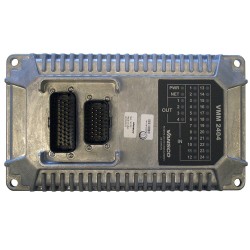Vansco Multiplexing Module VMM2404
The VMM2404 is a general purpose controller for vehicle and other applications with a steady voltage of less than or equal to 32 Vdc. VMM2404 has a 24 inputs and 4 high-side outputs as well as a CAN/J1939 communication port. The VMM2404 is 100% compatible with other Parker Vansco multiplexing modules.
The VMM2404 has 9 dedicated digital inputs, and 15 general purpose inputs capable of being configured for active high or active low signals. Additionally the general purpose inputs may be used for reading analog voltages, or as frequency inputs (2 AC coupled and 13 DC coupled).The VMM2404 has 4 high-side outputs with a max PWM frequency of 500 Hz, and 4 low-side outputs capable of current sensing. Outputs can drive any type of vehicle load including relays, solenoids, fans, etc.
Built to meet stringent SAE J1455/EP455 environmental standards, the system advances multiplexing technology through enhanced diagnostics and Windows-based ladder logic programming. The unit can be used alone or with other multiplexing modules. The multiplexing system was designed to simplify and reduce electrical system troubleshooting, maintenance, and file management time. The VMM modules are self-programming and have status LEDs that indicate the condition of inputs, outputs, power, and network activity.
The VMM2404 monitors its outputs continuously for fault information. Detected faults include short circuits (to ground or power), over currents and open load.
The VMM2404 allows systems to reduce the number of fuses by allowing the outputs to protect themselves electronically. In the event of a fault, the unit will disable the output(s) that are faulted. The VMM2404 has 30 red diagnostic LEDs that can be used to indicate the status of inputs, outputs, power and the Controller Area Network (CAN).
On-board diagnostics facilitate easier troubleshooting, and modules like the VMM2404 that can be auto-programmed relieve time and maintenance costs by keeping module and program inventory to a minimum. VMM users appreciate the module's robust design as well as its adherence to stringent industry environmental requirements and communications (SAE J1939) standards. All of these features make the controller easy to integrate into any on-highway or off-highway vehicle.
The VMM2404 has 9 dedicated digital inputs, and 15 general purpose inputs capable of being configured for active high or active low signals. Additionally the general purpose inputs may be used for reading analog voltages, or as frequency inputs (2 AC coupled and 13 DC coupled).The VMM2404 has 4 high-side outputs with a max PWM frequency of 500 Hz, and 4 low-side outputs capable of current sensing. Outputs can drive any type of vehicle load including relays, solenoids, fans, etc.
Built to meet stringent SAE J1455/EP455 environmental standards, the system advances multiplexing technology through enhanced diagnostics and Windows-based ladder logic programming. The unit can be used alone or with other multiplexing modules. The multiplexing system was designed to simplify and reduce electrical system troubleshooting, maintenance, and file management time. The VMM modules are self-programming and have status LEDs that indicate the condition of inputs, outputs, power, and network activity.
The VMM2404 monitors its outputs continuously for fault information. Detected faults include short circuits (to ground or power), over currents and open load.
The VMM2404 allows systems to reduce the number of fuses by allowing the outputs to protect themselves electronically. In the event of a fault, the unit will disable the output(s) that are faulted. The VMM2404 has 30 red diagnostic LEDs that can be used to indicate the status of inputs, outputs, power and the Controller Area Network (CAN).
On-board diagnostics facilitate easier troubleshooting, and modules like the VMM2404 that can be auto-programmed relieve time and maintenance costs by keeping module and program inventory to a minimum. VMM users appreciate the module's robust design as well as its adherence to stringent industry environmental requirements and communications (SAE J1939) standards. All of these features make the controller easy to integrate into any on-highway or off-highway vehicle.



